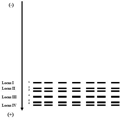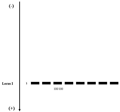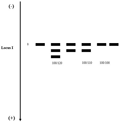1 Introduction
The penaeid shrimp resources of the country which constitute the coastal shrimp fishery occupy different ecosystems such as estuaries, inshore and offshore waters having its own distribution patterns, sizes and breeding activities. This situation requires monitoring of the population characteristics of each species separately to keep track of effects of exploitation of the stocks. Knowledge of stock composition is the fundamental tool for effective management of mixed stock fisheries, absence of this can lead to over exploitation. However, very little work has been done in India to determine to what extent the prawn stocks vary especially for
Penaeus species - which differ genetically along their spatial range of distribution. The green tiger shrimp
Penaeus semisulcatus is one of the commercially important penaeid shrimps species in both capture and culture fisheries due to its large size and fast growth rate. But, despite its wide distribution and commercial importance, very little long-term research on its biology has been published. In India, the species is abundant along the east coast than the west (
Kurian and Sebastian, 1976). In earlier years, more than half of the shrimp landings of Gulf of Mannar and Palk Bay were contributed by this species but declined in later years (
Nandakumar, 1980;
Manickam et al., 1989). The fishery (
Manisseri, 1982, 1986), biology (
Thomas, 1975, 1981) and growth (
Thomas, 1977) of
P. semisulcatus were studied in detail along the east coast. Juvenile fishery of the species was reported from Cochin backwaters (
Rao and Kathirvel, 1972) and Ashtamudi Lake (
Suseelan and Kathirvel, 1979). But the genetic structure of most economically important shrimp populations still remain unknown due to absence of gene frequency data. The stock studies of
P. indicus (
Paul, 2000) and
P. monodon (
Rebello, 2003;
Rebello et al., 2013, 2015a, b, c) stands first in this regard to assess the stock structure of these commercially important marine prawns. Electrophoretic studies on planktonic juveniles and adults of
P. indicus and
P. monodon also have been done (
Samuel, 1987).
Considering the importance of these studies, morphometric and electrophoretic investigations were carried out in commercially important
P. semisulcatus. Investigation on one of the variable factors among the species in morphological characters related to size, shape or other commercial characters are quite limited except for correlating these variations to the tail weight of the species (
Goswami et al., 1986;
Lester, 1990;
Lester and Pante, 1992;
George, 1997;
Paul, 2000;
Rebello, 2003,
Rebello et al., 2013, 2015a, b, c). The electrophoretic study of biochemical analysis of protein and enzymes - Aldehyde oxidase (AO), Aldolase (FBALD), Octanol dehydrogenase (ODH), and Esterase (EST) were done by Polyacrylamide Gel Electrophoresis (PAGE).
2 Materials and Method
Population samples of Penaeus semisulcatus were randomly collected from selected landing centres such as Kochi and Calicut of west coast of Kerala. These samples captured by trawl net, purchased from landing centres were frozen and transported to the laboratory in wet ice and then stored at -20ºC until used for experiments. A total of 80 specimens of P. semisulcatus with a length of 115 -171 mm and weight of 11- 54 g were collected.
2.1 Morphometrics
The thawed samples were weighed individually using the electronic weighing balance (in gram) and a set of 4 variables were measured (in mm) (
Fig.1). The variables measured were the depth of the abdomen (SSD) at the mid-point of the sixth segment; depth of the abdomen (SAD) at the intersection of the second and third segments, partial carapace length (PCL) from the posterior margin of the orbit to the posterior edge of the carapace; width of the carapace (CW) at the point of the last dorsal rostral tooth (
Table 1).

Fig. 1 Length variables measured in P. semisulcatus
Note: Total length (TL): Tip of the rostrum-tip of telson, Sixth segment depth (SSD): Depth at the mid-point of the 6th segment, Second abdominal segment depth (SAD): Depth at the mid-point of the 2nd and 3rd segment, Partial carapace length (PCL): Posterior margin of orbit-posterior edge of carapace, Carapace width (CW): At the point of the last dorsal tooth.
|
.png)
Table 1 Measured variables (mm) and weight (g) of P. semisulcatus
|
2.2 Biochemical genetics
The abdominal muscle tissue samples selected for the present study were homogenized (1 g/1 ml) in ice-cold DDW. After centrifuging at 6000 Xg for 30 minutes (-4º C), the supernatants were collected and stored in refrigerated condition (-20ºC) for further analysis. The supernatants were analyzed by Polyacrylamide gel electrophoresis (PAGE) using different percentages of gel, the band patterns (Zymogram) were detected by specific enzyme and protein staining procedures (
Shaw and Prasad, 1970,
Shaklee et al., 1990,
Rebello, 2003, 2013, 2015a, b, c). Electrophoresis was carried out in vertical slab gel apparatus (GENEI-Bangalore). Discontinuous buffer system was used for the present study. Buffer systems with different pH and molarity were tried for the present study.
3 Results and Discussion
3.1 Morphometrics
Among the four morphometric variables measured carapace width (CW) showed the highest correlation with the tail weight (TLW) (
Table 2). Considerable differences are not seen in tail weight, indicating the samples collected from Kochi and Calicut belongs to a single morphological stock. Similar studies were observed in studies carried out in
Merluccius merluccius (
George, 1964),
P. indicus (
George, 1997;
Paul, 2000) and in
P. monodon (
George, 1997;
Rebello, 2003;
Rebello et al., 2013, 2015a, b, c).
.png)
Table 2 Correlation Matrix between different morphometric characters of P. semisulcatus
|
3.2 Biochemical genetics
Optimum results were obtained with 7% gel composition. The total length of gel was 130 mm. 4 mA current was used for each well. Time for migration was about 1-2 hours. Results were obtained as shown below.
Zymogram of protein in muscle tissues of
P. semisulcatus shows 6 bands which were controlled by 4 loci (
Fig. 2 and Plate 1) in which, the 1st and 3rd loci showed one band and 2nd and 4th loci showed 2 bands respectively.

Figure 2 Zymogram pattern of Protein profile in muscle tissue of P. semisulcatus of Kerala coast
|
3.3 AO (Aldehyde Oxidase)
Though the enzyme Aldehyde oxidase showed two zones of activity, only a single thick band developed (
Fig. 3 and Plate 2). The allele AO-1*100 and AO-2*100 were accounted for the homozygous genotype.

Figure 3 Zymogram pattern of Aldehyde oxidase (AO) in muscle tissue of P. semisulcatus of Kerala coast
|
3.4 ODH (Octanol dehydrogenase)
The ODH enzyme showed only one major zone of activity in
P. semisulcatus (
Fig. 4 and Plate 3). The allele ODH*100 accounted for homozygous genotype.

Figure 4 Zymogram pattern of Octanol dehydrogenase (ODH) in muscle tissue of P.semisulcatus of Kerala coast
|
3.5 FBALD (Fructose biphosphate aldolase)
The enzyme aldolase showed only one zone of enzyme activity. The zone showed three, two and single banded polymorphic phenotypes (
Fig. 5 and Plate 4). The allele FBALD-1*100 accounted for the homozygous phenotype (100/100). The allele FBALD-1*87 accounted for the two banded heterozygous phenotype (87/100) and the allele FBALD-1*75 accounted for the three banded heterozygous phenotype (75/100). FBALD is monomeric in structure in
P. semisulcatus.

Figure 5 Zymogram pattern of Fructose biphosphate aldolase (FBALD) in muscle tissue of P.semisulcatus of Kerala coast
|
Considerable differences in banding patterns were not found in the stocks obtained from Calicut and Kochi. This can be related to the fact that the genetic makeup is similar (Homozygous). However, morphologically, biochemical genetically and even molecular genetically defined subunits (Stocks) of fisheries management have been identified and reported with in many species of the maritime nations including that of India (
Lester, 1990;
Lester and Pante, 1992). A very small variation (FBALD*100/100; FBALD*100/120) was obtained from Calicut samples for FBALD, but there was no significant variation observed.
Cadrin S.X., 2005, Landmark morphometrics. In Cadrin, S.X., Friedland, K.D., Waldman, J. (Eds.), Stock Identification Methodology (Elsevier Academic Press, Amsterdam) p. 153–172
George M.K., 1964, Electrophoretic and Biochemical studies on European hake, Merluccius merluccius (L). Ph.D Thesis
George M.K., 1997, Genetic studies on marine penaeid prawns. Report on USIF scheme-PL-480, Central Marine Fisheries Research Institute, Kochi
Goswami U., Dalal S.G., and Goswami S.C., 1986, Preliminary studies on prawn, Penaeus merguiensis, for selection of brood stock in genetic improvement programs, Aquaculture, 53: p. 41-48
Kurian C.V. and Sebastian V.O., 1976, Prawns and prawn fisheries of India, revised fifth edition, Hindustan Publishing Corporation (India) Delhi. 307 pp
Lester L.J., 1979, Population genetics of penaeid shrimp from the Gulf of Mexico, J. Herd, 70: 175-180
Lester L.J., 1990, Subspecific stock identification of Northeastern South American shrimp fishery, In: A.C. Jones and L. Villegas (Eds.), Proceedings of the working group of shrimp fisheries of Northeastern South America, WECAF Reports, 28: 131-143
Lester L.J. and Pante M.J.R., 1992, Genetics of Penaeus species, In. Marine shrimp culture: Principles and practices, Arlo, W., Fast and L. James Lester (Ed). (Elsevier Science Publishers) p. 29-52
Manickam S.P.E., Arputharaj M.R., and Rao P.V., 1989, Exploitation of juveniles of green tiger prawn, Penaeus semisulcatus, along the Palk Bay and its impact on the fishery of the region, National Symposium on Research and development in Marine Fisheries, CMFRI Bulletin, 44: 137-145
Manisseri M.K., 1982, On the fishery of juveniles of Penaeus semisulcatus along the Tinnevelly coast, Tamil Nadu, Indian J. Fish., 29 (1&2):20-28
Manisseri M.K., 1986, On the fishery of Penaeus semisulcatus and its distribution in relation to depth along Tinnevelly coast, Southern India, Indian J. Fish., 33(4):402-412
Nandakumar G., 1980, Observations on the prawn fishery of the Mandapam area, Indian J. Fish., 27 (1&2): 257-260
Paul B., 2000, Population genetic structure of the marine Penaeid prawn- Penaeus indicus H. Milne Edwards, 1837, Ph. D Thesis, Cochin university of Science and technology, Kochi, India
Rao P.V., and Kathirvel M., 1972, On the seasonal occurrence of Penaeus semisulcatus (de Hann), Panulirus polyphagus (Herbst) and Portunus (P) pelagicus (Linn.) in the Cochin backwater, Indian J. Fish., 18 (1&2): 112-134
Rebello V.T., 1992, Biochemical and Histological studies of selected tissues of Macrobrachium nobilii (H. Milne Edwards), M. Phil thesis, 75pp.
Rebello V.T., 2003, Genetic studies of the marine penaeid prawn, Penaeus monodon Fabricius, 1798, Ph.D Thesis. 80pp. Cochin University of Science and Technology, Kochi
Rebello V.T., George M.K., and Sathianandan T.V., 2013, Morphometric stock structure of tiger shrimp, Penaeus monodon of southeast and southwest coast of India, J. Mar. Biol. Ass. India, 55 (2), 11-15, July-December, 2013
Rebello V.T., George M. K., Paulton M.P., and Thomas P.C., 2015a, An Investigation on the molecular genetic profile of tiger shrimp, Penaeus monodon Fabricius, 1798, International Journal of Applied Research (IJARPF), 1(12) A : 11-17
Rebello V.T., George M. K., and Paulton M.P., 2015b, Population genetic stock structure of the Indian jumbo tiger prawn, Penaeus monodon Fabricius, 1798 from south-east and south-west coast of India, International Journal of Applied Research (in Press)
Rebello V.T., George M. K., Paulton M.P. and Ajith Joseph. C., 2015c, Allozyme markers of the jumbo tiger prawn Penaeus monodon Fabricius, 1798 from east and west coast populations of south India. International Journal of Biosciences (in press)
Samuel P., 1987, Biochemical genetics of selected commercially important penaeid prawns, Ph.D Thesis, Cochin University of Science and Technology, Kochi, India
Shaklee J.B., Phelps S.R., and Salini J., 1990, Analysis of fish stock culture and mixed stock fisheries by the electrophoretic characterization of allelic isozymes. In: D.H. Whitmore (Ed.) Electrophoretic and Isoelectric Focusing Techniques in Fisheries Management. CRC Press Inc., Florida, USA, p. 173-196
Shaw C.R., and Prasad R., 1970, Starch gel electrophoresis of enzymes-a compilation of recipes, Bioche. Genet. 4: p. 297-320
Suseelan C., and Kathirvel M., 1979, A good nursery ground for tiger prawns located in Kerala, Mar. Fish. Infor. Serv. T&E Ser., 12: 8-9
Thomas M.M., 1975, Reproduction, fecundity and sex ratio of green tiger prawn Penaeus semisulcatus (de Hann), Indian J. Fish., 21 (1): 152-163
Thomas M.M., 1981, Food and feeding habits of Penaeus semisulcatus (de Hann) at Mandapam, Indian J. Fish., 27 (1&2): 130-139

 Author
Author  Correspondence author
Correspondence author

.png)
.png)






